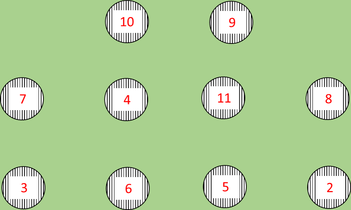At the game, WBA honoured the memory of their legendary striker Jeff Astle by wearing a replica strip from their 1968 FA Cup win. Astle scored the winning goal with a header. He died in 2002 after suffering from a brain condition (chronic traumatic encephalopathy) more commonly associated with boxers and more recently with American football players. One of the interesting aspects of the replica kit was the numbers the players wore on their shirts. The outfield players wore numbers 2 to 11 and the goalkeeper's shirt did not carry a number.
I previously wrote about the role of numbers on shirts in team sports (here). At the time I asked about ten people to give me the numbers they would allocated to the positions if they were putting out a team. Most of those I asked gave me the team numbers for both 4-4-2 and 4-3-3 formations. None matched the 4-4-2 numbers that WBA used on Saturday. According to the BBC's Match-of-the-Day programme, WBA played as shown in the graphic below. The major difference between the graphic and my survey was that my "experts" had 8 in the middle on midfield and 11 on the side. There was also a divide on whether the centre-halves should wear 4 & 5 or 5 & 6.
One of the reasons players now get assigned a particular number is an economic one. Namely it allows those purchasing replica kids to identify with a particular player (see some previous posts on shirtonomics by David Butler here and here).

 RSS Feed
RSS Feed